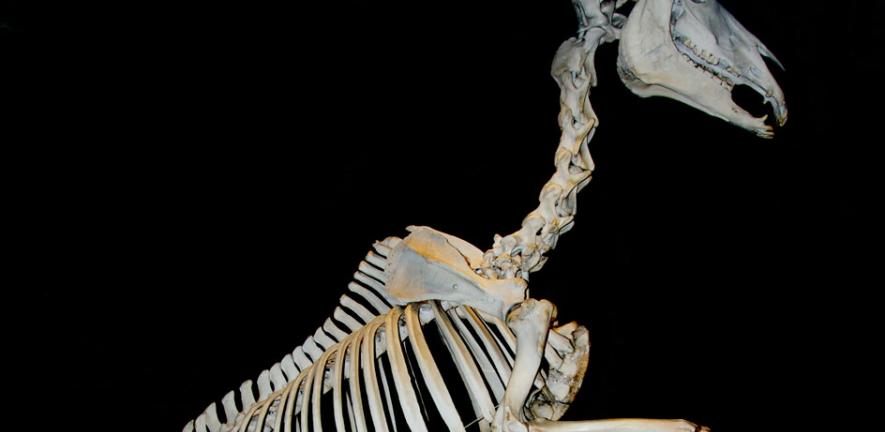
All British thoroughbred racehorses, including Polymelus, are descended from three stallions – the Darley Arabian, the Godolphin Arabian and the Byerley Turk.
All British thoroughbred racehorses, including Polymelus, are descended from three stallions – the Darley Arabian, the Godolphin Arabian and the Byerley Turk.
What is it?
This imposing skeleton of a horse stands at the entrance to the University of Cambridge Zoology Museum on the New Museums Site. It is the skeleton of a thoroughbred race horse called Polymelus (which translates as many-limbed) and was donated to the Museum in the 1930s – and shows the anatomy of a horse capable of impressive speed.
All British thoroughbred racehorses, including Polymelus, are descended from three stallions – the Darley Arabian, the Godolphin Arabian and the Byerley Turk. The three stallions were imported from the Middle East at the turn of the 18th century and crossed with a total of 74 British and a few imported mares to produce horses for racing. In 1753, the Godolphin Arabian was buried within the stable block at Wandlebury House, former home of the Earl of Godolphin, near Cambridge, where his grave stone can be seen today.
Cambridge University Library holds some of the most important historical documents relating to the establishment of the British thoroughbred lineage – including early volumes of the National Stud Book and the records of the first known autopsy of a horse by a veterinary surgeon.
What’s the story?
Polymelus lived from 1902 to 1924 and was the sire (father) of a string of leading racehorses foaled (born) between 1914 and 1921. His son Phalaris was a champion racehorse who went on to sire (father) many winners. Among Polymelus’s other descendants are Secretariat and Northern Dancer who also became legends in their time.
Recently tiny samples of DNA were taken from one of the teeth of the skeleton of Polymelus. They were analysed at the McDonald Institute for Archaeological Research (part of the Cambridge University) as part of an inter-disciplinary project tracing the genes for speed and stamina found in modern thoroughbreds backwards in time to discover their origins. The DNA of 12 historic horse skeletons was screened, including that of Eclipse, the most famous of all.
The work, which showed how rapidly the genetic make-up of a breed can be shaped by humans, will help throw light on common health problems experienced by thoroughbreds. Interestingly, the speed gene which gives horses their sprinting ability was traced back to one of the British mares used at the early stages of the development of the British thoroughbred line.
Can we see it?
The skeleton of Polymelus stands in the foyer of the University of Cambridge Zoology Museum, which contains collections of national and historical importance. The Museum is open Monday to Friday, 10.00 – 16.45, and Saturday 11.00 – 16.00. The Museum runs regular activities for children. Entrance is free.
Want to find out more?
Visit the National Horse Racing Museum in Newmarket https://www.nhrm.co.uk/. Read the The Sport of Kings: Kinship, Class and Thoroughbred Breeding in Newmarket by Rebecca Cassidy who took a PhD in anthropology at Cambridge and now works at Goldsmiths College London.
This work is licensed under a Creative Commons Licence. If you use this content on your site please link back to this page.

